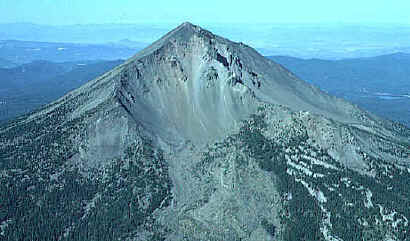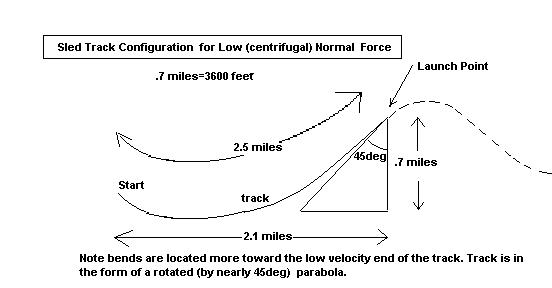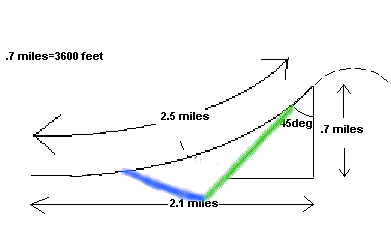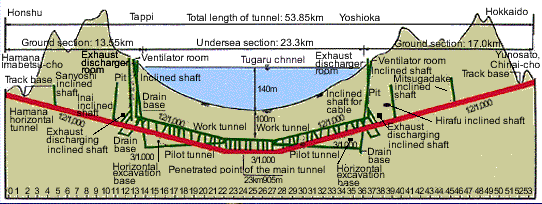SKY RAMP TECHNOLOGY
Spaceports have been a popular topic for many years. Ideally, future spaceports will function like today's efficient airports, launching several spacecraft a day once an inexpensive method of space launch becomes reality. Sky Ramps will finally allow frequent space launches since the launch sleds can be quickly reused. After launch, they can be inspected for damage, a new RLV mounted and both the sled and RLV fueled and ready for launch within hours.
The easiest place to build Sky Ramps is up the side of large mountains.
A sled may "blast off" from an inclined fixed pad like today's rockets, or ramp up
from a
horizontal track. A ski jump type ramp at the end seems attractive,
but the g force would kill RLV occupants. Therefore, any sharp upward
curve in the track must occur before reaching 400mph, unless the payload
will not include humans. Another problem with high curving g forces is they
strain the track, making construction more difficult. 
Another factor is launch noise and sonic booms, although no one complains about the noise from Cape Kennedy launches. This will result in interesting battles among environmental groups and those supportive of local jobs and inexpensive space flight. Sky Ramps will also provide a tourist attraction since a booming spacecraft shooting up a mountain at over 1000mph every hour will be a great draw for local ski resorts.
The Death Valley area of California has several interesting remote areas in which the elevation begins BELOW sea level and rapidly rises over 10,000 feet. Nevada and New Mexico also have promising locations. Due to the steep angle needed, extinct volcanoes seem to provide the best locations. Generally, you want a 10,000 foot rise within two miles, which will require some cutting and bridging.
The best Sky Ramp spaceports sites are
overseas. Ecuador has numerous mountains
near the equator that are over 20,000 feet. Of course political
cooperation and agreements are needed, but such sites have many physical
advantages. Sites in Chile, Indonesia, and New Guinea also look promising.
Once again, Sky Ramps can be built anywhere, but locations farther from the equator
require a longer track for the RLV to make orbit. An added advantage of Sky
Ramps is that actual launch occurs two miles above sea level where the
atmosphere is only half as dense. This may seem insignificant, but the
Space Shuttle burns thousands of pounds of fuel just to push its bulky
non-aerodynamic body through the Earth's dense lower atmosphere.
The detailed launch example in the X-33 section proves an X-33 size RLV can be launched at Mach 2 and into orbit off a 2.5 mile straight track under 6 Gs. However, finding a 8000 foot rise with a 45 degree slope is not simple. Another option is a curved track, which fits better with typical mountain slopes. It may even begin with a downward free roll from a nearby mountain to provide several hundred mph of free speed from gravity. However, the curve in the track must end well before the RLV reaches Mach to prevent high downward G s.
One drawback with a curve is that imposes much more stress on the track and RLV, but nothing catastrophic. Steel "rib" supports may be needed on the sled to reinforce the RLV's fuel tank walls. The free roll downhill also saves fuel so the entire sled is lighter. This also makes return of the empty sled or an aborted launch much easier since it wouldn't have to be lowered, it could just roll back down and the reverse slope would slow it down.
High mountains are
not essential if a tunnel track is used. It is possible to dig a two-mile
declined tunnel at sea level to launch a rocket up a two-mile inclined Sky
Ramp. The mining industry has the expertise to build such things.
Any solid mountain can be used as depicted in this diagram, where a downward
"blue" access tunnel provides a path a few thousand feet below a
mountain. It connects to a perfectly inclined "green" launch
tunnel. Some cutting or tunneling is needed for almost all Sky Ramps since the
Earth is unlikely to provide perfect terrain. Tunnels also muffle the
launch noise.
sea level to launch a rocket up a two-mile inclined Sky
Ramp. The mining industry has the expertise to build such things.
Any solid mountain can be used as depicted in this diagram, where a downward
"blue" access tunnel provides a path a few thousand feet below a
mountain. It connects to a perfectly inclined "green" launch
tunnel. Some cutting or tunneling is needed for almost all Sky Ramps since the
Earth is unlikely to provide perfect terrain. Tunnels also muffle the
launch noise.
This is a very modest proposal compared to the massive railway tunnels constructed around the world. For example, the Seikan Tunnel in Japan (below) is over 33 miles long. It provides an example of a "V" tunnel variation. A sled could start at a surface support area and simply roll down a 2.5 mile declined tunnel to gain hundred miles an hour just from gravity. As it reaches the bottom, its rockets fire as it curves upward to launch an RLV at a 75 degree angle at a speed of Mach 2. A five mile long space launch tunnel may seem expensive, but it would not make the list of the world's 100 longest railway tunnels.
 Unfortunately, most space launch sites today are near sea level,
so there may be great concern and possible opposition voiced by those running
today's launch pads. However, there was similar concern when large
airports began to displace the huge passenger rail stations 50 years ago.
Sky Ramps are the future that political and bureaucratic forces cannot
halt. If the USA refuses to adopt this method for inexpensive Space launch,
innovative foreign governments may overtake American dominance in Space. The
Japanese and Germans are evaluating the use of horizontal rails to launch
spaceplanes, which eliminates the need for heavy landing gear for a fully fueled
take-off. They may realize that inclining those ramps can provide
substantial assisted launch.
Unfortunately, most space launch sites today are near sea level,
so there may be great concern and possible opposition voiced by those running
today's launch pads. However, there was similar concern when large
airports began to displace the huge passenger rail stations 50 years ago.
Sky Ramps are the future that political and bureaucratic forces cannot
halt. If the USA refuses to adopt this method for inexpensive Space launch,
innovative foreign governments may overtake American dominance in Space. The
Japanese and Germans are evaluating the use of horizontal rails to launch
spaceplanes, which eliminates the need for heavy landing gear for a fully fueled
take-off. They may realize that inclining those ramps can provide
substantial assisted launch.
We asked one of America's civil and geological experts to evaluate the feasibility of constructing a huge Sky Ramp. He asked that his name not be used, but he is the director of geological engineering at a major university who has worked on major projects and has about every civil and geological engineering qualification possible. He wrote:
"I have no doubt that a launch ramp can be built on the side of a mountain.
But, the problem would be in finding a tall enough and steep enough mountain
with uniformly-sloping sides so that track curvature would be minimal. The
east flank of Mt. Whitney is the sort of site I suspect that you would need.
Even this gives only about 9000ft of height and would require a significant
curvature in the lower 1/3 to 1/2 of the track. And, large segments of the
track would need to be elevated - probably several hundreds feet - to reduce
track curvature. This will be a problem at almost every site, but not
necessarily insurmountable. Money cures all, and NASA seems to have
plenty. Also, I suspect that environmental and aesthetic considerations
would require development on private land - the structure clearly won't enhance
the natural setting, and while engineers will marvel at it, many will find it
quite ugly and intrusive. One possible government location is inside the
huge Nevada test range.
I find the idea of a near vertical drilled shaft more
interesting and practical. The South African gold mines go to, I think,
about 14,000 ft (nearly three miles). So, we have the technology to
construct a long, straight shaft. However, the size of the shaft may be a
problem. I would seem that a rectangular shaped shaft formed from two or
three parallel tunnel boring machine (TBM) tunnels might do the trick, but some
technological advancements would probably be needed. Multiple raised
boring machine shafts may also do the job, but precise alignment could be
difficult. There are also various sorts of shaft sinking machines.
Alternatively, conventional drilling and blast shaft sinking will always work.
In addition to the shaft you will need fairly large underground facilities, but,
again, these are within the realm of modern technology.
For launching through a mountain peak it may also be
necessary to construct a horizontal tunnel for access and venting, unless the
plan is to lower the vehicle down the shaft and vent through the launch shaft.
Remember, though, that the highest peaks in the US are only about 15,000 ft and
the adjacent areas are typically at elevations of at least several thousand
feet. Therefore, for a three mile deep shaft it will be necessary to
excavate a shaft several thousand feet deep and several miles from the launch
site just to connect the access tunnel to the launch pad. Nevertheless,
I think that all of the problems are solvable and within the realm of current
technology.
The Whittier Access Project, a 2.5 mile 16-foot wide tunnel in high-cost Alaska, was built for only $80 million. Our example is for a 2.5 mile track to launch the X-33, but a Mach 1 assist only requires a 1.25 mile track. Even a one-mile track inclined 45 degrees would be valuable for launching two-stage to orbit vehicles, large unmanned single-stage rockets at high Gs, or large sub-orbital aircraft.
Some people have expressed concern about air pressure build-up if a tunnel is used. One solution is to make the tunnel wide enough so its not a problem. Venting shafts with huge fans could remove much of the air during launch. Closing the tunnel at the end and pumping out the air presents problems with opening the door during launch. However, not all air can be pumped out, so the RLV will pick up trace elements and it ascends and will gradually build up greater air pressure that can pop the hatch open just in time. The Swissmetro achieves 500 kph (310 mph) in maglev passenger rail tunnels by pumping out half the air. These are important issues, but not insurmountable. Overall, the cheapest and easiest method of inclined rail launch is a mountainside curved track.
Less Air Resistance
Another advantage of mountain launches is less air density. Air particles in our atmosphere slow spacecraft as they push upward. Few people realize that launching from 18,000 feet cuts the air resistance problem in half, and just 8000 feet cuts it 25%. Nevertheless, NASA insists on launching spacecraft from sea level.
This table gives density in slugs per cubic foot because it uses the American system of altitude in feet, pressure in inches of mercury and temperature in degrees Fahrenheit. While people often use pounds per cubic foot as a measure of density in the U.S., pounds are really a measure of force, not mass. Slugs are the correct measure of mass. You can multiply slugs by 32.2 for a rough value in pounds.
Altitude Pressure Ave.Temp. Density -
(ft) (in. Hg) (F.) slugs per cubic foot
0 29.92 59.0 0.002378
1,000 28.86 55.4 0.002309
2,000 27.82 51.9 0.002242
3,000 26.82 48.3 0.002176
4,000 25.84 44.7 0.002112
5,000 24.89 41.2 0.002049
6,000 23.98 37.6 0.001988
7,000 23.09 34.0 0.001928
8,000 22.22 30.5 0.001869
9,000 21.38 26.9 0.001812
10,000 20.57 23.3 0.001756
11,000 19.79 19.8 0.001701
12,000 19.02 16.2 0.001648
13,000 18.29 12.6 0.001596
14,000 17.57 9.1 0.001545
15,000 16.88 5.5 0.001496
16,000 16.21 1.9 0.001448
17,000 15.56 -1.6 0.001401
18,000 14.94 -5.2 0.001355
19,000 14.33 -8.8 0.001310
20,000 13.74 -12.3 0.001267
25,000 11.10 -30.15
30,000 8.89 -47.98
35,000 7.04 -68.72
40,000 5.54 -69.70
45,000 4.35 -69.70
50,000 3.43 -69.70
55,000 2.69 -69.70
60,000 2.12 -69.70
65,000 1.67 -69.70
70,000 1.31 -69.70
75,000 1.03 -69.70
80,000 0.81 -69.70
85,000 0.64 -64.80
90,000 0.50 -56.57
95,000 0.40 -48.34
100,000 0.32 -40.11Source: Aerodynamics for Naval Aviators
©2008 Sky Ramp Technology